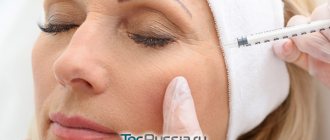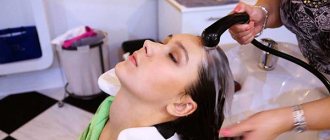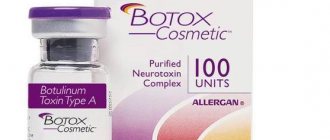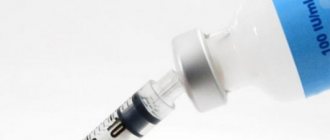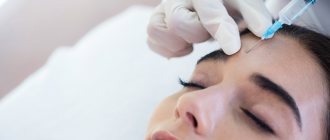Today, more and more people resorting to anti-aging procedures are faced with the consequences of unsuccessful Botox, which not only negatively affect their appearance, but are also dangerous to health. A special advantage of injections is that with their help you can restore youth in the shortest possible time, and the result lasts from 5-6 months to a year. But in some cases, the administration of Botox leads to many negative consequences. A person who is faced with the results of an unsuccessful procedure needs to know what actions will help quickly remove the drug from the body and eliminate the resulting defects in appearance.
How long does Botox last?
Botox is an anti-aging drug made from a toxic substance – botulinum toxin. Using the product in small quantities, due to temporary paralysis of muscle fibers, helps improve the overall condition of the skin and smooth out wrinkles, eliminate squint and drooping eyelids.
If negative consequences occur after an anti-aging procedure, you need to know whether Botox is completely eliminated from the body, and whether this process can be accelerated. The drug is excreted by the kidneys already 3-4 weeks after injections, but the effect can be observed from six months to 12 months.
The following factors influence how quickly Botox is eliminated from the body:
- body mass;
- metabolic rate;
- dose of the administered drug;
- patient's gender;
- immunity;
- Botox injection area.
In addition to the above factors, the person’s age should be taken into account - the younger the patient, the faster the drug will be eliminated. How often the rejuvenating procedure is performed also plays a significant role. If a person is injected with Botox more than 2 times a year, then gradually the body will become accustomed to the components of the drug, and muscle function will be restored after 3-4 months.
Side effects of anti-aging injections
Side effects from Botox can occur for a variety of reasons. In most cases, their manifestation is caused by the patient’s failure to comply with the rules of the rehabilitation period or intolerance to the active substance. However, the consequences of unsuccessful Botox, which require correction, can be the result of such medical errors as an incorrectly established puncture zone, exceeding the dose of the drug or its poor quality.
The most common side effects include:
- Asymmetry of individual parts of the face - excessive raising of the eyebrows, drooping of the corners of the mouth or cheeks;
- Diffusion of a drug is the movement of the active substance into the blood, neighboring tissues or muscles;
- Excessive tearing or excessive dryness of the eye mucosa, vision problems;
- Ptosis - excessive drooping of the eyelids, inability to open the eyes;
- Excessive drooling, numbness of the mouth and problems with speech.
It is important to accurately determine the cause of side effects in order to know how to neutralize the effects of Botox. For more serious consequences, such as anaphylactic shock, hypoxia and diseases of internal organs, prompt medical attention is required.
Pros and cons of the method
Using botulinum toxin to smooth out wrinkles has its advantages and disadvantages. The advantages of using the drug include:
- high efficiency of the procedure;
- minimal pain during the botulinum toxin injection procedure;
- long-lasting effect – at least 4-6 months;
- less likely to have complications and side effects compared to surgical correction;
- the possibility of use for preventive purposes, even before the appearance of deep wrinkles;
- short rehabilitation period.
Botulinum therapy also has a number of disadvantages. These include:
- the risk of going to an inexperienced doctor who will incorrectly calculate the dosage of the medicine and cause paralysis of the facial muscles;
- side effects - headaches, swelling under the eyes;
- ineffectiveness of Botox in correcting nasolabial folds;
- different duration of the effect – the possibility of rapid restoration of innervation due to the individual characteristics of the patient’s body.
Cosmetological methods to weaken the effect of Botox
To eliminate the negative consequences of an unsuccessful procedure, you need to know how to weaken the effect of Botox. To quickly get rid of side effects, it is necessary to accelerate the removal of the active substance from the body.
There are several ways to do this. Of the methods proposed by modern medicine for removing botulinum toxin from the body, the most effective are magnetic stimulation, electrical stimulation and ultrasound therapy. No less effective methods include galvanization and darsonvalization.
Important: all procedures should be carried out only with a doctor’s prescription and under his close supervision, since only a qualified and experienced specialist knows how to remove Botox from the lips, around the eyes and other areas of the face.
Magnetic stimulation
Magnetic stimulation is one of the most popular procedures to remove the effects of Botox. During its implementation, the skin is exposed to special devices with low-frequency magnetic fields, which leads to a weakening of the active substance and its removal from the body naturally.
The procedure helps improve blood circulation and activate metabolism. Magnetic stimulation, affecting deep tissues, accelerates the regeneration of the skin and improves its general condition. This method of weakening Botox is prescribed for strabismus and blurred vision. The effect, depending on the severity of the problem, is noticeable after 9-10 procedures.
Electrical stimulation
Another effective way to remove Botox from the face is electrical stimulation. It involves exposing problem areas to low-frequency pulsed electric current. This procedure allows you to restore muscle activity not only after unsuccessful Botox, but also after a stroke and orthopedic surgery.
Exposure to low-frequency electrical impulses provokes increased contraction of smooth and skeletal muscles. Electrical stimulation helps eliminate the consequences of unsuccessful Botox even several weeks after the anti-aging procedure.
Ultrasound therapy
Ultrasound therapy is also used to eliminate the negative results of skin rejuvenation. Exposure to ultrasound leads to improved blood circulation and acceleration of the movement of tissue molecules. This method helps normalize metabolic processes and regenerate the skin.
Ultrasound therapy is prescribed to accelerate the removal of botulinum toxin from the body. The procedure helps remove Botox from the forehead and head.
Galvanization
An equally effective method for removing Botox from the body after an unsuccessful procedure is galvanization. Its implementation helps to activate metabolic processes, remove excess fluid and botulinum toxin.
Galvanization is one of the types of hardware massage, during which problem areas are exposed to a weak current of low voltage with a constant frequency. A positive result can be observed after 12-14 procedures. It is important to know that galvanization is contraindicated in the presence of inflammatory processes, oncology and blood diseases.
Darsonval
To eliminate the consequences of an unsuccessful anti-aging procedure, a special Darsonval device is also used. It operates on the basis of pulsed alternating current of low strength, but intense frequency and high power.
Doctors use this device to treat diseases of the central nervous system. Also, under its influence, Botox is eliminated from the body much faster than naturally. The device allows you to improve the passage of nerve impulses and enhance muscle contraction. The effect of the procedure can be noticed after 10-13 sessions.
Deviation from the norm
According to experts, the appearance of periodic headaches is a standard reaction of the body after botulinum toxin injections. However, if they last more than 4 days, this is a serious cause for concern.
When a migraine is accompanied by severe nausea, high fever and flu-like symptoms, you should immediately call a doctor. Otherwise, the following violations may develop:
- hypotension;
- kidney problems;
- slowing down metabolic processes.
Disturbances in the functioning of the cardiovascular system and blood circulation are also possible. Therefore, it is not worth the risk.
If you have a severe headache after Botox injections, you should definitely take non-steroidal anti-inflammatory drugs. They suppress the production of the hormone responsible for this reaction of the body.
Please note: not all medications are compatible with botulinum toxin. Therefore, before choosing a product, be sure to consult with a specialist.
Ice compresses will also help relieve headaches . You need to take a few cubes, wrap them in cotton cloth, apply them to your forehead and leave for 15 minutes. Another positive reaction can be achieved with a regular massage, which must be done for half an hour.
What you can do yourself at home
You can speed up the removal of botulinum toxin from the body not only in the hospital, using special devices, but also on your own. You can reduce the effect of Botox at home with the help of special massages, physical exercises and medications.
Massage
Massage can be performed either by a specialist or independently with your hands or using special massage devices. But before performing it, you should definitely consult a cosmetologist.
Important: manual massage is recommended no earlier than 2 weeks after administration of the drug. Massaging earlier than the specified period is fraught with aggravation of the resulting consequences.
Hand massage is performed by alternating stroking and tapping along massage lines. All actions are performed symmetrically. It is necessary to massage even those areas where there is no active substance.
Massaging problem areas will help improve blood circulation, speed up metabolic processes and restore muscle function, which will quickly remove Botox from the body and eliminate the negative consequences caused by the rejuvenating procedure.
Physical exercise
To make Botox dissolve faster, it is recommended to resort to physical activity. You should do morning exercises at home every day and go to the gym at least 3 times a week.
You can also weaken the effect of botulinum toxin by steaming. To do this, it is recommended to take a hot bath, visit a hot bath or sauna at least once a week. Such measures will help to significantly improve blood circulation and reduce the effectiveness of anti-aging injections.
Taking medications
Any person who has suffered from unsuccessful anti-aging injections is interested in whether there are medications that neutralize the effect of Botox. Such medications exist, but they should not be taken without a doctor's permission. It is recommended to take medications if Botox fails only with a doctor’s prescription, otherwise you can harm your health even more.
The most effective medications that weaken the effect of botulinum toxin include antibiotics, hormonal and antiviral agents, antidepressants and anticoagulants, and herbal alcohol tinctures. It is advisable to take medications in the first days after the administration of anti-aging injections; in a later period, their use will not bring the desired result.
Alcohol
The doctor who administered Botox always warns the patient not to drink alcohol. Many people believe that the ban is due to the fact that alcohol, when it enters the body, promotes faster elimination of the active substance. Having made this conclusion, a person who has encountered negative consequences after anti-aging injections begins to drink alcohol.
You need to know that alcohol will not significantly weaken the effect of Botoxulin, but it will provoke many health problems. Drinking alcohol leads to dilation of blood vessels, which after Botox injection is fraught with swelling, the formation of hematomas and bruises.
Video: How to remove Botox?
Complications after Botox
Such a familiar and common procedure as Botox injections, however, is not harmless. But still, the effect of the drug is limited in time (3-6 months), so complications will not last long.
Complications after the administration of botulinum toxin type A can arise both through the fault of the doctor and the fault of the patient. Let's start with the doctor, because the safety and effectiveness of the procedure will depend on the initial choice of the specialist.
Botox injections can ruin your face for a long time 93966
The doctor is to blame
The most common mistake when working with botulinum toxin preparations is failure to follow the protocol for working with the drug - here are the most common mistakes made by cosmetologists:
Violation of dilution proportions . Leads to insufficient effect or, on the contrary, excessive blocking of the activity of facial muscles. Today it is possible to correct an insufficient dose by additional administration of botulinum toxin or, conversely, to eliminate an overdose of botulinum toxin antagonist drugs.
Inconsistency between the dose of the drug and muscle strength in a certain area : an insufficient dose causes a mild block. In case of overdose, complications are manifested by drooping tissues of the forehead and glabellar region in one or more adjacent areas.
Introduction of the drug into an area not intended for correction , which can result in a variety of complications:
- facial asymmetry, swelling in the periorbital area, like
- violation of eyelid closure, ptosis (drooping) of the eyebrows or, more often, the upper eyelids,
- articulation disorder that affects speech function
- difficulty eating when the drug is injected into the area around the mouth.
Frequent injection of high doses of botulinum toxin into the extraocular muscles leads to drooping of the eyelids, their swelling and visual disturbances (double vision, increased sensitivity to light). Eye irritation and dryness, watery eyes, and impaired ability to blink may also occur. As a rule, such complications go away on their own within a few days (weeks), but it is very advisable to use artificial tears to avoid keratitis.
If a cosmetologist injects Botox incorrectly, your eyelid may droop, like Paris Hilton's. 94642
When it comes to treating complications such as ptosis, brow drooping is more difficult to reverse than eyelid drooping. However, there is little consolation: the effect of Botcos does not last forever - in a maximum of six months, the activity of the paralyzed muscles will resume.
The patient is to blame
Failure by the patient to comply with the conditions of the rehabilitation period - incorrect body position immediately after injections, drinking alcohol in the coming days, thermal procedures or any stimulating procedures - all this increases the risk of complications or significantly shortens the duration of the drug.
Therefore, firstly, tell your doctor only the truth: what medications you are taking and when, whether you are currently menstruating, or prone to allergic reactions. Intense exercise should be avoided for two hours after injections. It is also forbidden to lie down. Within 24 hours after the injection, you should not massage or rub your face to avoid the risk of spreading botulinum toxin outside the correction areas.
Toxin or injection to blame
It happens that the doctor and the patient fulfill all the conditions perfectly, but complications still develop. In general, adverse reactions after Botox injections develop during the first week and are transient. Rarely do they last for several months or longer.
The classification of complications after Botox can be expanded - those associated with the active substance (botulinum toxin) or those associated with the injection (the actual procedure that violates the integrity of the skin). But for convenience, we will consider them by time of occurrence.
So, an immediate allergic reaction associated with the introduction of a toxin develops during the first hours after the procedure. If you suddenly notice signs of an allergic reaction: red rash on the skin, itching; difficulty breathing, swelling of the face, lips, tongue, or throat - immediately take an antihistamine (even Suprastin) and call an ambulance: rarely, but after Botox anaphylactic shock can develop.
In the first days after Botox injections, you may experience inflammation, soreness at the injection site, swelling, redness, bruising and flu-like symptoms. They develop very rarely and go away on their own within a few days.
During the first week, chronic infectious diseases (bacterial or viral) may worsen, often an exacerbation of herpes infection. Wounds or ulcers at the injection site are a reason to see a doctor immediately.
Botox is used not only for cosmetic purposes; botulinum toxin is used to treat migraines, overactive bladder, and excessive sweating, which is why botulinum toxin has participated in many clinical studies. The test results, as recommended by the FDA, also apply to cosmetic Botox, so the following general complications are very rare after cosmetic procedures. But still call your doctor if you experience any of these serious side effects, which may occur in the first few weeks after the injection:
- breathing problems, difficulty speaking or swallowing
- hoarse voice,
- unusual muscle weakness (especially in areas distant from the injection site);
- severe skin rash and itching;
- fast or slow heart rate
- chest pain spreading down the arm or shoulder,
- poor general health.
Dementia after numerous Botox injections. Well, the main thing for a woman is not to be smart, but to be beautiful! cruel joke
Conclusion
Thus, the results of unsuccessful Botox can be eliminated in various ways, not only with the help of doctors, but also independently at home. It is necessary to understand that it is much easier to prevent negative consequences than to deal with them. Having decided to undergo anti-aging injections, you need to take a responsible approach to choosing a clinic and a specific specialist.
You should study the available reviews about the work of the selected cosmetologist. An experienced, qualified doctor always conducts a consultation before the procedure, carefully examines the characteristics of the skin and identifies the presence of contraindications, tells what should not be done before and after injections. Only a real specialist can administer Botox in compliance with all rules of sterility and safety, which will avoid side effects.
What to do if you have a headache?
Before taking any action, it is necessary to accurately assess the cause of the pain. If the headache is mild and does not last more than two weeks, then this can be considered the body’s response to Botox.
If the headache is accompanied by vomiting, fever or tachycardia, then it is recommended to consult a doctor.
Common manifestations of mild headaches can be relieved with analgesic medications. But before deciding what to do and what medicine to take, you need to consult your doctor.

